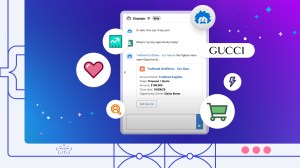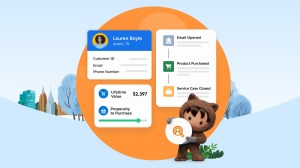This summer, email marketing turned 40 years old. In 1978, Digital Equipment Corporation (DEC) sent out the first marketing email to 400 potential clients via the Advanced Research Projects Agency Network (ARPANET). The campaign resulted in $13 million worth of sales in products, and demonstrated the effectiveness of email marketing–an approach that still works today. In fact, for many marketers email is still king, driving the most ROI of any marketing channel.
To mark the occasion of nearly half a century of email marketing, the Salesforce Newsroom team interviewed Joanna Milliken, senior vice president of product management for Salesforce Marketing Cloud.
In this interview, Joanna, who has been in the email marketing industry for nearly 20 years, discusses the evolution of email marketing and what’s ahead, including the impact of artificial intelligence (AI). She also discusses the profound importance of personalized email and new Salesforce innovations in transactional email communications.
In the past 40 years, how has the use of email evolved?
Email has evolved, but even more than that, it has sustained itself. It’s staying power is incredible. It’s the golden goose that keeps giving. And at Salesforce, we’re proud to say we’re the most used email marketing provider in the industry, constantly delivering new Marketing Cloud innovations that brands such as USA Today, Lids, Kroger, adidas and many others turn to every day to better engage with consumers.
As for its evolution, in the early days email marketing was the preferred choice by marketers to replace direct mail. From the onset, it became clear that the biggest benefit of email marketing is the capability to personalize communications. To this day, personalization is essential to providing consumers with relevant promotions, content and information. Now, AI and emerging technologies like voice are redefining email marketing strategies. These steps forward have all helped email deliver outstanding ROI over the years.
Email marketing has come a long way. What are some of the biggest innovations in email marketing more recently?
Today’s consumers are demanding relevant experiences. And they’re expecting them across more channels than ever before. Our research shows that people use 10 different channels to communicate with companies. In this hyper-connected world, marketers need to rethink their approach to email marketing. They need to determine when it makes sense turn to the channel and how best to leverage it throughout the consumer journey.
In terms of email itself and how it has evolved, scale and performance have improved dramatically. In other words, both the number of emails marketers can send has grown and the effectiveness of email communications has evolved to help marketers reach the right consumers with the right information.
Additionally, personalization has come a long way and is continuing to evolve, as it’s the Holy Grail of marketing. Sophisticated marketers can build entire consumer journeys that are tailored to consumers and include email communications, social media marketing, digital advertising and more.
When it comes to email marketing specifically, marketers today have tools to build dynamic, widget-like experiences within emails that engage with specific audiences in the right moments. For example, let’s say a woman is shopping for running shoes. After browsing the Web for a few options, including visiting her favorite retailer, she is likely to receive an email within minutes from that preferred retailer. The email features a promotion with a live countdown clock, and some alternative sneaker options as suggestions.
Most recently, AI technology has helped companies surface powerful insights about their consumers and how best to market to them.
How is AI making a difference in email marketing?
With AI, marketers are able to know more precisely what audience to engage with, what information to include in emails and know exactly when to send them. AI has also eliminated some of the technical work associated with developing personalized emails. This way, marketers can focus on building campaigns, work on creative and more.
AI is also helping marketers determine copy that should go into subject lines and headlines, and it is informing what kinds of offers work and don’t work with consumers. Many companies are using AI to optimize send times, and are also gaining insights into the likelihood someone will unsubscribe from emails. As we move forward, AI will also help improve at what frequency recommendations are made.
Can you think of a customer that has moved its business forward thanks to new innovations in email marketing?
We’re only starting to scratch the surface of AI in email, but the results to-date are impressive. In fact, our customer Lids recently adopted Marketing Cloud Einstein and has been able to greatly improve email marketing efficiency as a result. Prior to Einstein, Lids did a test showing an email open rate of just 5.9 percent. Since adopting Einstein a couple of months ago, the company’s email open rate has grown to 27 percent. Lids also experienced a 2.5x increase in average click-through rate–a pretty big boost.
Ticketmaster is another good example. We featured Ticketmaster on-stage during Salesforce Connections this year, our marquee event for marketing, commerce and service pros. The company has turned to email marketing with Salesforce to better engage with ticket buyers and improve their entertainment experience. Recently, Ticketmaster also adopted Einstein to make smart, personalized recommendations about concerts and events for each email subscriber. As a result, Ticketmaster has seen remarkable engagement from its consumers.
Salesforce is beefing up transactional email. What is transactional email is and why is it important?
Many people misunderstand transactional email and commingle what triggered and transactional emails are. The key to understanding the difference is that all transactional email is triggered, but not all triggered email is transactional. For example, if you get a “your item has shipped” email after making a purchase online, that’s a transactional email.
Transactional emails are a vital component of every marketer’s email marketing program. Transactional messages deliver important information at just the right time–like receipts, delivery notifications or password resets. Customers anticipate these emails and open them within minutes, providing a great way for brands to boost consumer engagement and grow their subscriber base. One way a transactional email can grow subscribers is with offers. For example, a marketer can include a “Sign up for exclusive offers” call to action within a transactional email.
A lot of companies turn to separate providers for their transactional email needs, which can lead to disconnected communications and a poor consumer experience with a brand. As a solution, we have integrated transactional email into Marketing Cloud–the same platform that marketers use for all of their campaigns.
What are some transactional email innovations that Salesforce is working on?
We already enable marketers to send transactional emails to consumers within Marketing Cloud, but we’re looking to extend our capabilities. We’re currently working on empowering marketers to send transactional messages via SMS, as well as messaging apps–all within Marketing Cloud. Here is how it would work: If a consumer uses a rideshare service and prefers to receive receipts over SMS versus email, the rideshare service will be able to share transactional messages across that specified channel.
By deploying transactional email communications within Marketing Cloud, marketers will be able to better map out connected consumer journeys, and understand when is best to engage with transactional or promotional messages so that the consumer receives a cohesive brand experience.
More information about Marketing Cloud can be found here.
What does Salesforce’s partnership with Google and the acquisition of Datorama mean for email marketers?
A couple of months ago, we announced integrations between Marketing Cloud and Google Analytics 360. Now, marketers around the world are able to deliver meaningful consumer experiences powered by the world’s #1 marketing platform and a market-leading web analytics product. As part of the integration, consumer insights from both Marketing Cloud and Analytics 360 can be viewed in a single journey analytics dashboard in Marketing Cloud, giving marketers access to cross-channel insights all in one place. Marketers can visualize how email, mobile and web interactions are performing–and most importantly, how they are impacting each other.
With the acquisition of Datorama, we are going to be able to let email marketers visualize performance in entirely new ways, through AI-informed dashboards. Datorama will play an important role in letting email marketers move well beyond the KPIs they are used to, and view the performance of their email campaigns. They will be able to make smarter recommendations and decisions surrounding what email marketing campaigns are working. Email marketers are interested in everything from how much it costs to acquire a new subscriber to what subscribers are really interested in. With Datorama and our Google partnership, it will be much easier to get meaningful insights in these key areas.
Looking ahead, what does the future of email marketing look like?
There’s no doubt that AI is the key to the future of marketing overall, including email marketing. Our Salesforce State of Marketing report finds that 75 percent of marketers using AI say it’s absolutely or very essential in helping their company create 1-to-1 marketing across every touchpoint.
As I speak with our customers, I see email marketers thinking outside of their silo. For marketers, the goal is to understand consumer preferences and engage with them across all channels. Email is a major part of the consumer journey, but it’s important to understand how one channel influences the other, and how best to deliver the experiences that consumers want. Looking ahead, marketers are also beginning to integrate ecommerce interactions so that if a consumer is interacting with a retailer, for example, a marketer can act on that intelligence with tailored email communications right away.
Over time, email will become much more interactive. Email clients are getting more flexible, enabling video or animation in emails. Many of the elements marketers can add to a website, marketers couldn’t incorporate in email. That’s changing, thanks to everything from HTML5 to CSS. We’ll see more of these innovations in email, as well as emails opening up in chat conversations and messengers. We’ll also see voice come to life within email as consumers interact with chatbots or conduct searches all within the inbox.
Over the last several years, a robust ecosystem around email marketing has emerged. Salesforce is proud to be the trusted leader in the industry, and is pleased to have many great partners in the space through Salesforce AppExchange.
Fun question: What’s on your music playlist right now?
My primary playlist is called Guilty Pleasures – and it has a huge variety of artists – everything from Jack White to Leon Bridges and Modest Mouse to the Rolling Stones. We listen to music in our house constantly and love it all.













